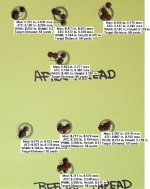D
Donald
Guest
There may just be something to removing a bit of material by threading the muzzel. Last fall I had about 2.5 inchs threaded 36/in on a fairly good shooting Bartlein barrel. The barrel had about 700 or a bit more rounds thru it. I am kind of like Bill here, I ain't no great shooter. After threading was done and before installing a 5.5 oz MD (muzzel device) I shot a couple of groups with one of the best loads that barrel shot. Both were quite a bit larger than what it normally shot. Then I screwed on the MD. Not having a clue as to where to stop. Shot a group....it was somewhat better than the other 2 for sure. Then I turned the MD 1/4 turn in and the group got much smaller, in fact as small as the barrel ever shot. Then I turned the MD in about 1/8 more and the group opened up a bit. Turned it back to the 1/4 spot and that group was just about like the other one shot with 1/4 turn in from the original setting. Since then I had the MD off to reduce the weight as it had put me a bit overweight. The rifle now is at 10# 7.8 oz. So screwed the MD back on but quite a bit farther onto the barrel. Testing again showed me that 1/4 turn total got it right back in tune. Beats me, but I figure with this setup it is never more than 1/4 turn out of tune. But I do know that it works.........Donald
But I do know that it works.........Donald




